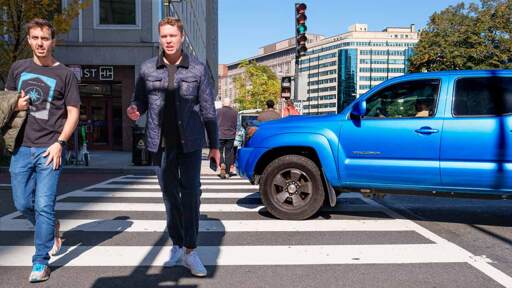IIHS researchers analyzed pedestrian crashes to develop injury risk curves showing how speed affects crash outcomes. They found that the effect of crash speed on injury risk was magnified for vehicles with taller front ends. Compared with risk curves developed using crash data from Europe, where tall passenger vehicles are less common, risk curves for the U.S. show pedestrians here begin to suffer more serious injuries at lower speeds.



Injury is caused in the inelasticity of the collision, the energy absorbed by the body. To compute that we need to know both the vehicle’s speed and it’s mass. However, this study ignored mass. The best it can do is find a correlation. Very little of the article’s conclusions in causation or implied remedies have much merit.
A high school physics student should be able to explain this in terms of momentum, energy, and scientific method. An AP student can also do the math. By second year of post-secondary they can communicate it to another. The actual scientific paper wouldn’t dare present in such a ridiculous manner as this article.
It’s relative mass that matters. Weight of a car to the weight of a person is so high that a vehicle being 5 times heavier than another vehicle is irrelevant.
Like I said above, a high school physics student knows better than this.
Show us your math so we can laugh at you.
You sound like someone who has learned to critique scientific papers, but hasn’t learned enough about how to actually improve on their methods. You sound like an absolute dick.
The paper shows vehicle height contributing to more serious outcomes. You could infer that the weight of the vehicle is correlates with vehicle height and therefore the mass of the collision is incorporated in the data. Vehicle height has the added benefit of also incorporating collision strength as pedestrians can’t fall on the hood of the car and have that absorb some of the impact. There are huge vehicles that will probably hit me right in the head on a collision which would further contribute to the severity of the impact.
You sound like someone who lacks the reading comprehension to perceive that I differentiated the underlying science from the article’s presentation. So, you resorted to ad hominem while explaining vehicle physics to someone with a mechanical engineering degree with automotive specialty.
You’re not talking science, you’re being nitpicky, condescending, and pedantic.
You can talk science when you bring out the math, demonstrating the scale of differences of vehicle weight on the acceleration of a pedestrian, or when you have published your own safety study.
At the risk of feeding the troll, here is the math you are suggesting we do, which disproves all of your arguments. It pains me how confidently you speak of a topic you are clearly so uneducated about: your physics mentors should be disappointed in you.
Conservation of linear momentum:
m1v1i + m2v2i = m1v1f + m2v2f
Let the vehicle be m1 and the human m2. Let the human’s initial velocity be zero. Let us further assume an inelastic collision: the human and vehicle end up at the same final speed v1f=v2f=vf.
Thus:
m1v1i = (m1+m2)vf
What we are concerned of is the ratio of initial vehicle speed, v1i, to post-collision speed vf. Your argument is that a lighter vehicle will have a larger drop-off in speed, recovering energy and reducing the severity of the collision. If you were right, the ratio v1i/vf should be less than 1.0, and be significantly different for a heavy and light vehicle. We will prove this wrong shortly.
Rearranging:
v1i/vf = m1/(m1+m2)
Already it is abundantly clear that when m1 >> m2, v1i/vf will be 100%. I will leave you no room for counterargument here by working two examples. Take the most popular pickup truck, the Ford F150, at 2125 kg. Take one of the smallest compact cars, a Honda Fit, at 1130 kg. Take the average adult human, at 65 kg.
For the F150: v1i/vf = 2125/(2125+65) = 97%
For the Honda fit: v1i/vf = 1130/(1130+65) = 95%
At 35 mph, that’s a difference in speed delta of 0.7 mph, which is absolutely insufficient to explain the delta in injury severity presented in this article.
This proves what everyone knew all along: vehicle mass is insignificant in crash severity with a pedestrian because the masses of the two objects are so different. When the masses are similar (e.g. a small car colliding with a big car) yes, mass is important. But that’s not what is being discussed and is not your argument.
I hope you go back to school and learn the basics before confidently acting superior. Take your downvotes and learn from this to do better.
This is where you went wrong.
But, you’re not asking questions. So, I’ll not invest into answers.
A vehicle with a higher front end is going to be a bigger one with more mass so the results will probably be not to far off from if they actually used mass, but yeah kinda dumb. Maybe they were trying to find alternate wording because the average bigg truxx appreciator won’t know what mass means.
Science doesn’t work on shitty assumptions, big boy.
big boy not always smart boy…
and like I said how many ‘high front end’ vehicles are driven by people that even believe in science? Based on the bumper stickers I’ve seen on trucks, or the trucks I’ve seen under bumper stickers, not many in my town. This isn’t even trailerpark, usa… things are looking not too great.
Now fallacies and anecdotes. You’ve never even owned a truck. LOL.